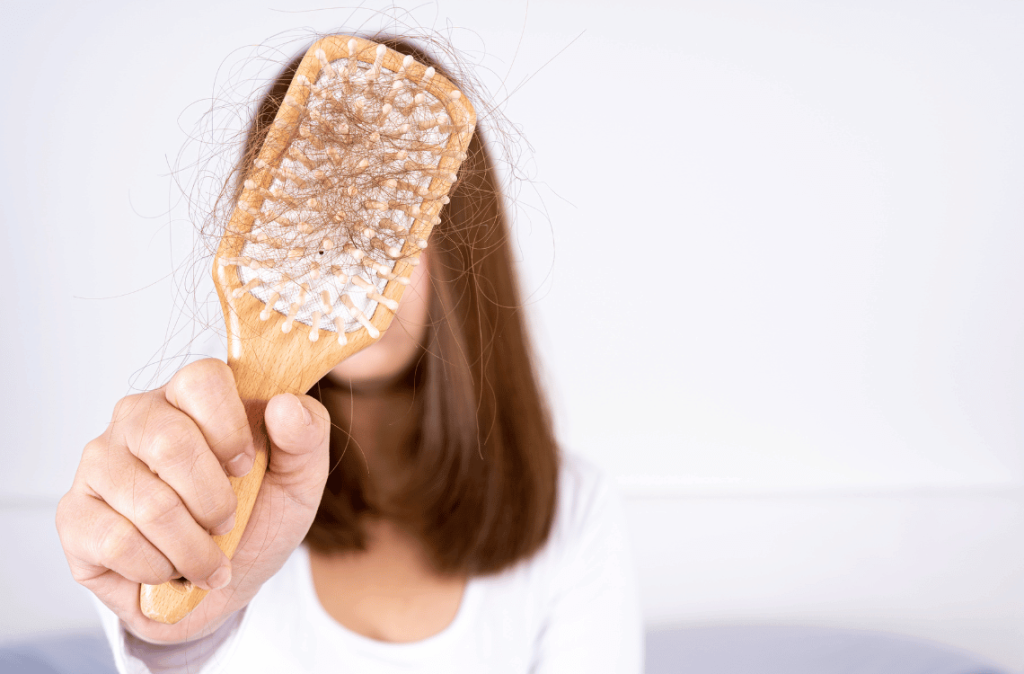Navigating the postpartum period often whirls new mothers through joy, adaptation, and various bodily changes. Among these, postpartum hair loss presents a common yet often unexpected challenge, causing concern.
However, understanding that this condition is normal and usually temporary can offer significant reassurance. This expanded guide delves deeper into postpartum hair loss, providing a detailed understanding of its causes, timelines, and comprehensive strategies for effective management.
What Causes Postpartum Hair Loss?
The Role of Hormones
Postpartum hair loss, or telogen effluvium, results from hormonal fluctuations experienced after giving birth. During pregnancy, the high estrogen levels in the body prolong the growing phase of the hair cycle, leading to thicker and fuller hair.
Conversely, after delivery, as these hormone levels decline to their pre-pregnancy states, more hairs enter the shedding phase.
This shift is a natural response to the body’s hormonal rebalancing and is a key factor in why new mothers experience hair loss during this time.
When Does Postpartum Hair Loss Start?
Timing and Identification
The onset of postpartum hair loss generally occurs two to four months after childbirth. This period coincides with the body’s efforts to recalibrate its hormone levels to those before pregnancy.
Identifying the start time of hair loss is crucial for mothers, as it helps distinguish postpartum hair loss from other types of hair loss conditions that may require different treatments or interventions.
How Long Does Postpartum Hair Loss Last?
Duration and Recovery
Although the experience of postpartum hair loss varies among individuals, it typically resolves within six to twelve months after it begins.
During this recovery phase, the hair cycle gradually returns to its normal rhythm and improves hair density.
This regrowth period signifies the body’s return to its pre-pregnancy physiological state, with hair thickness and health gradually being restored.
Ways to Prevent and Treat Postpartum Hair Loss
Nutrition and Hair Care
While it’s challenging to prevent postpartum hair loss entirely due to its hormonal basis, adopting specific measures can lessen its severity and promote healthier hair regrowth:
Maintain a Balanced Diet
A diet rich in essential vitamins and minerals is fundamental for hair health. Vitamins such as Vitamin E and D, along with minerals like iron and omega-3 fatty acids, play a critical role in supporting hair strength and growth.
Incorporating various nutrient-dense foods into your diet ensures that your body and your hair have the necessary components for optimal health.
Gentle Hair Care
Minimizing stress on the hair is vital during this vulnerable time. Using a soft-bristled brush helps detangle without pulling excessively, reducing breakage.
Additionally, avoiding tight hairstyles and minimizing the use of heat styling tools can prevent further stress on your hair follicles, aiding in more hair retention.
Stress Management
High-stress levels can exacerbate hair loss, making stress management techniques such as yoga, meditation, or deep-breathing exercises beneficial.
Ensuring adequate rest and prioritizing self-care are equally important, as they help lower stress levels, potentially mitigating hair loss.
Stay Hydrated
Adequate hydration is crucial for maintaining overall health, directly impacting hair health.
Water supports the regulation of the hair growth cycle and helps transport nutrients to the hair follicles, promoting hair growth and health.
Consider Supplements
After consulting with a healthcare provider, taking supplements designed to support hair growth can be beneficial.
Supplements containing biotin, zinc, and vitamins specifically formulated for hair health can provide the nutrients that might be lacking in your diet, supporting healthier hair growth.
Tips for Dealing with Postpartum Hair Loss
Coping Strategies
Effectively managing postpartum hair loss involves a blend of practical and cosmetic approaches:
Use Volumizing Shampoos
Volumizing shampoos can make a significant difference in the appearance of your hair. These products are designed to add body and volume, making your hair look fuller and thicker.
Plus, they can be particularly beneficial during periods of thinning.
Avoid Harsh Treatments
Chemical treatments and frequent heat styling can further damage delicate hair and exacerbate hair loss.
Opting for natural styling methods and reducing the frequency of chemical treatments can help preserve hair health and minimize shedding.
Experiment with Hairstyles
Trying new hairstyles that add volume or change the appearance of your hair can also be effective.
Shorter cuts can reduce the weight on your scalp, making your hair appear fuller, while layers can add volume and texture, camouflaging thinner areas.
Consider Hair Accessories
Accessories like scarves, headbands, and clips offer stylish ways to manage hair loss and provide a creative outlet for personal expression.
These accessories can cover thinning areas while adding a fashionable element to your look.
Patience is Key
It’s important to remember that postpartum hair loss is temporary. Patience and giving your body the time it needs to recover is crucial.
Hair growth will eventually return to normal, and understanding this can help alleviate stress and concern during the process.
Seek Professional Advice
If you’re experiencing significant hair loss or if it persists beyond the typical timeframe, it’s advisable to consult a healthcare provider or dermatologist.
They can offer personalized advice, recommend treatments, and rule out other potential causes of hair loss.
Thus ensuring you receive the appropriate care.
Conclusion
Postpartum hair loss is a temporary condition that many new mothers face.
You can navigate this period with confidence and resilience by understanding its causes, recognizing its typical timeline, and applying effective prevention and coping strategies.
Remember, this phase is just one part of your postpartum journey, and with the right care and patience, your hair health can be restored, allowing you to focus on the joys of motherhood.
